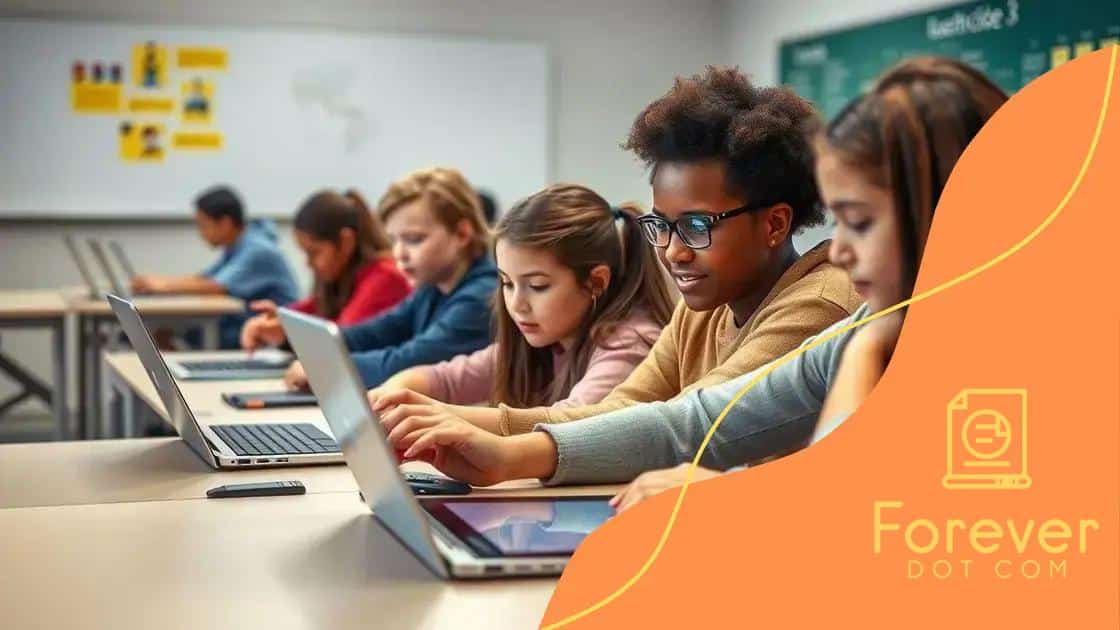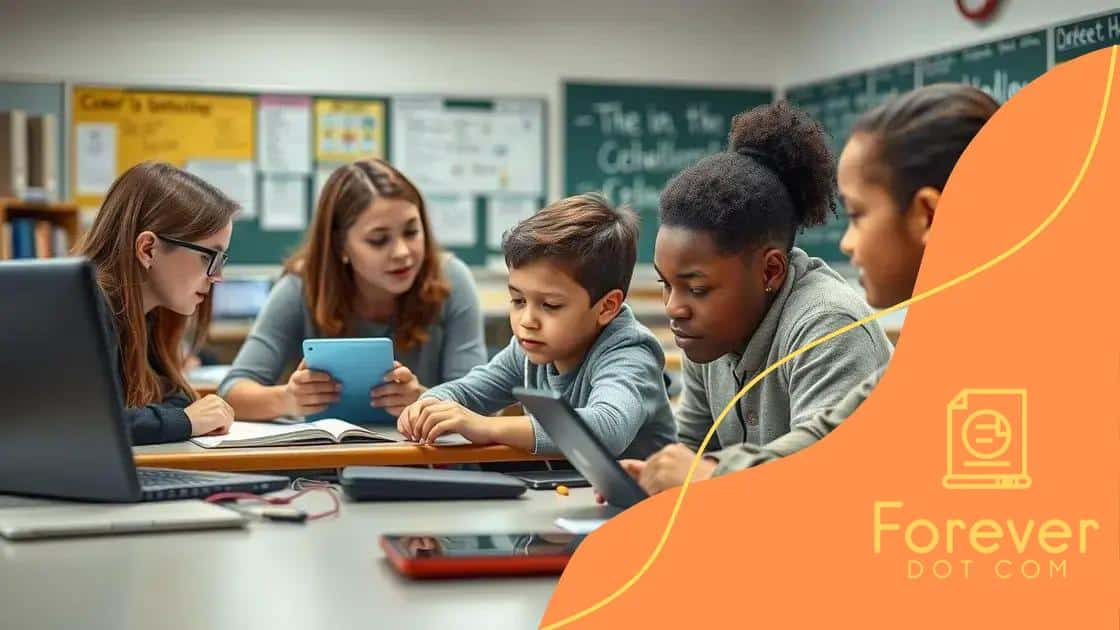How digital tools are transforming K-12 classrooms

Digital tools are transforming K-12 classrooms by enhancing student engagement, personalizing learning through AI, and fostering collaboration while also presenting challenges like costs and equitable access.
How digital tools are transforming K-12 classrooms is a fascinating journey into the evolution of education. Have you ever wondered how these advancements affect student learning and engagement? Let’s explore this transformation together!
Benefits of digital tools in K-12 education
Digital tools in K-12 education bring numerous benefits to both students and teachers. As classrooms evolve, it becomes essential to understand how these tools can enhance the learning experience. Engagement is significantly improved when students interact with technology. They tend to show a greater interest when learning through interactive platforms rather than traditional methods. This increase in engagement can lead to better educational outcomes.
Your student can benefit from various digital tools, such as:
- Collaboration platforms: These tools allow students to work together on projects, regardless of their physical location.
- Learning management systems: They provide organized access to resources and assignments, streamlining the learning process.
- Interactive learning apps: These applications make challenging subjects more accessible and fun, improving retention.
- Assessment tools: Digital assessments can provide instant feedback, helping teachers identify areas for improvement.
Teachers also experience advantages. They can create customized lesson plans using digital resources tailored to their students’ needs. Additionally, these tools provide valuable insights into student performance, allowing for more informed instructional decisions.
The availability of online resources and tutorials can aid in professional development, enabling educators to improve their skills and adapt to new technologies without extensive training. Moreover, digital tools can help foster a more inclusive environment by catering to different learning styles. By providing multiple ways to access information, all students, including those with disabilities, can participate fully in the learning process.
Furthermore, digital tools save time for educators. They can automate grading and other administrative tasks, allowing teachers to focus on what truly matters—teaching. For students, this means more time to dive into projects and deepen their understanding of subjects.
Overall, the advantages of digital tools in K-12 education can lead to a more engaging and effective learning environment. By embracing technology, both students and teachers can foster a culture of innovation and creativity in the classroom.
Popular digital tools shaping classrooms
Many digital tools are popular in today’s K-12 classrooms, each serving unique purposes to enhance the learning experience. These tools transform traditional education methods into exciting, interactive environments. Some key tools include:
- Google Classroom: This platform streamlines assignments and offers a space for teachers and students to collaborate effectively.
- Kahoot!: This game-based learning platform makes studying fun through quizzes and interactive sessions that boost student engagement.
- Nearpod: This tool allows teachers to create interactive lessons with real-time feedback, engaging students with new types of content.
- Microsoft Teams: This communication tool facilitates collaboration and sharing among students and educators, helping to keep everyone connected.
The use of tablets and laptops has made a huge difference. Students can now access a wealth of information and resources at their fingertips. Digital tools cater to various learning styles, making education more personalized. For instance, programs like Duolingo help students learn languages interactive and engaging, while Khan Academy offers empowering resources for understanding complex subjects like math and science.
In addition to these tools, many schools are adopting virtual reality (VR) and augmented reality (AR) technologies. These innovations provide immersive learning experiences that transport students to historical events or even distant planets. Through VR, students can explore environments that would otherwise be inaccessible, enriching their understanding of the world around them.
With these tools, communication also improves. Teachers can provide instant feedback and maintain open lines with parents and guardians. This approach creates a support system that extends beyond the classroom.
Overall, digital tools are reshaping how students learn and interact in the classroom. As these tools become even more integrated into everyday education, they offer endless opportunities for creativity and innovation, paving the way for a brighter future in learning.
Challenges of integrating technology in schools
 Integrating technology in schools comes with its own set of challenges. While the benefits are clear, it is essential to address potential obstacles to ensure successful implementation. One major challenge is the cost of technology. Schools need to invest in devices, software, infrastructure, and training, which can strain budgets, especially for underfunded districts. Educators often need resources to effectively integrate these tools into their lessons.
Integrating technology in schools comes with its own set of challenges. While the benefits are clear, it is essential to address potential obstacles to ensure successful implementation. One major challenge is the cost of technology. Schools need to invest in devices, software, infrastructure, and training, which can strain budgets, especially for underfunded districts. Educators often need resources to effectively integrate these tools into their lessons.
Some common challenges include:
- Training for teachers: Educators must receive proper training to feel confident using new tools. Without ongoing support, they may struggle to utilize technology effectively.
- Access and equity: Not all students have equal access to technology at home, which can widen the gap in learning opportunities.
- Resistance to change: Some teachers may resist adopting new methods and prefer traditional teaching styles. This mindset can slow down the integration process.
- Technical issues: Schools might face difficulties with internet connectivity and tech malfunctions, which can disrupt the learning experience.
Addressing equity is crucial. Schools need to ensure that every student has access to the technology they need. Providing devices and internet access to disadvantaged students can help level the playing field.
Furthermore, schools must foster a culture of digital literacy. Encouraging students to develop essential skills for using technology can prepare them for future challenges. This means incorporating technology into curricula not just as tools but as subjects worthy of learning.
Ultimately, successful integration requires a shift in mindset for both educators and students. Schools should embrace technology as an ally in education rather than a barrier. By working together to overcome these challenges, educational institutions can provide a more engaging and effective learning experience for all students.
Strategies for effective tech implementation
Implementing technology in schools effectively requires thoughtful strategies. When done right, technology can enhance learning experiences and outcomes. One important step is to create a clear implementation plan. This plan should outline objectives, timelines, and resources needed for integration. Involving key stakeholders, such as teachers, students, and parents, in the planning process ensures that everyone is on board.
Some effective strategies include:
- Professional development: Providing ongoing training for teachers is essential. Workshops and collaborative sessions help them become comfortable with new technologies.
- Pilot programs: Testing new tools with a small group before a wider rollout allows schools to gather feedback and make necessary adjustments.
- Regular evaluation: Schools should continuously assess the effectiveness of technology use. This can be done through surveys and performance metrics, enabling timely adjustments to strategies.
- Student involvement: Engaging students in the process can provide insights into what works best. Their feedback is vital for successful tech implementation.
Creating an environment that encourages innovation is also key. Schools should foster a culture where educators feel free to experiment with new tools and teaching methods. This approach not only empowers teachers but also inspires students to embrace technology in their learning.
Moreover, building a reliable IT support system is crucial. Schools need technical assistance readily available to address any issues that arise. This support ensures that both teachers and students can focus on learning rather than troubleshooting.
Finally, promoting a collaborative culture among teachers can strengthen technology integration. Educators sharing their experiences and best practices leads to a more cohesive approach in the classroom. By working together, teachers can create a richer educational experience that leverages digital tools effectively.
Future trends in digital education
The future of digital education is bright and filled with exciting advancements. As technology continues to evolve, educational methods will shift to incorporate new tools and techniques. One of the most significant trends is the rise of artificial intelligence (AI) in education. AI can personalize learning experiences by adapting lessons to meet individual student needs. This tailored approach helps ensure that every student can learn at their own pace and style.
Another key trend is the increasing use of virtual reality (VR) and augmented reality (AR). These technologies create immersive learning environments that engage students in ways traditional methods cannot. Imagine studying history by walking through ancient ruins or exploring the solar system from your classroom. As VR and AR become more accessible, their use in education will likely grow, providing unique experiences that enhance engagement.
Additionally, blended learning is gaining popularity. This method combines online digital media with traditional classroom methods, offering students flexibility in how they learn. With blended learning, students can access resources anytime, anywhere, making education more convenient and adaptable to their busy lives.
Moreover, there is a shift toward more emphasis on social-emotional learning (SEL). Educators are recognizing the importance of developing students’ emotional intelligence alongside academic skills. Digital tools can support this by providing students with resources and activities that promote mindfulness and collaboration.
Finally, the growth of collaboration platforms allows for deeper connections among students, teachers, and parents. These tools create a community where everyone is involved in the learning process. Students can work together on projects, teachers can share resources, and parents can stay informed about their children’s progress.
In summary, the future of digital education promises to be interactive, personalized, and focused on the holistic development of students. As technology advances, these trends will shape how we teach and learn, paving the way for a more engaged and prepared generation.
In conclusion, the transformation of K-12 education through digital tools is only beginning. Embracing technology can create engaging and personalized learning experiences for students. The integration of artificial intelligence, virtual reality, and collaborative platforms will reshape how we teach and learn. However, overcoming challenges like costs and training is crucial for success. As we move forward, focusing on innovative strategies will ensure that every student is equipped with the skills needed for the future. Together, we can build a more dynamic and effective educational landscape for all learners.
FAQ – Frequently Asked Questions about Digital Tools in K-12 Education
How can digital tools enhance student engagement?
Digital tools create interactive and fun learning experiences, encouraging students to participate actively in their education.
What role does artificial intelligence play in education?
AI personalizes learning by adapting content to meet individual student needs, ensuring everyone can learn at their own pace.
What are some challenges of integrating technology in schools?
Challenges include costs for devices and training, as well as ensuring equitable access for all students.
How do collaboration platforms benefit classrooms?
They promote teamwork among students, facilitate communication with teachers, and help keep parents informed about their children’s progress.






